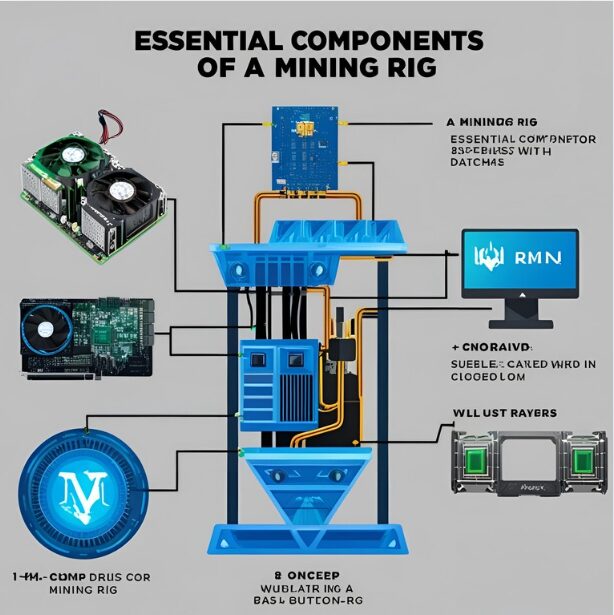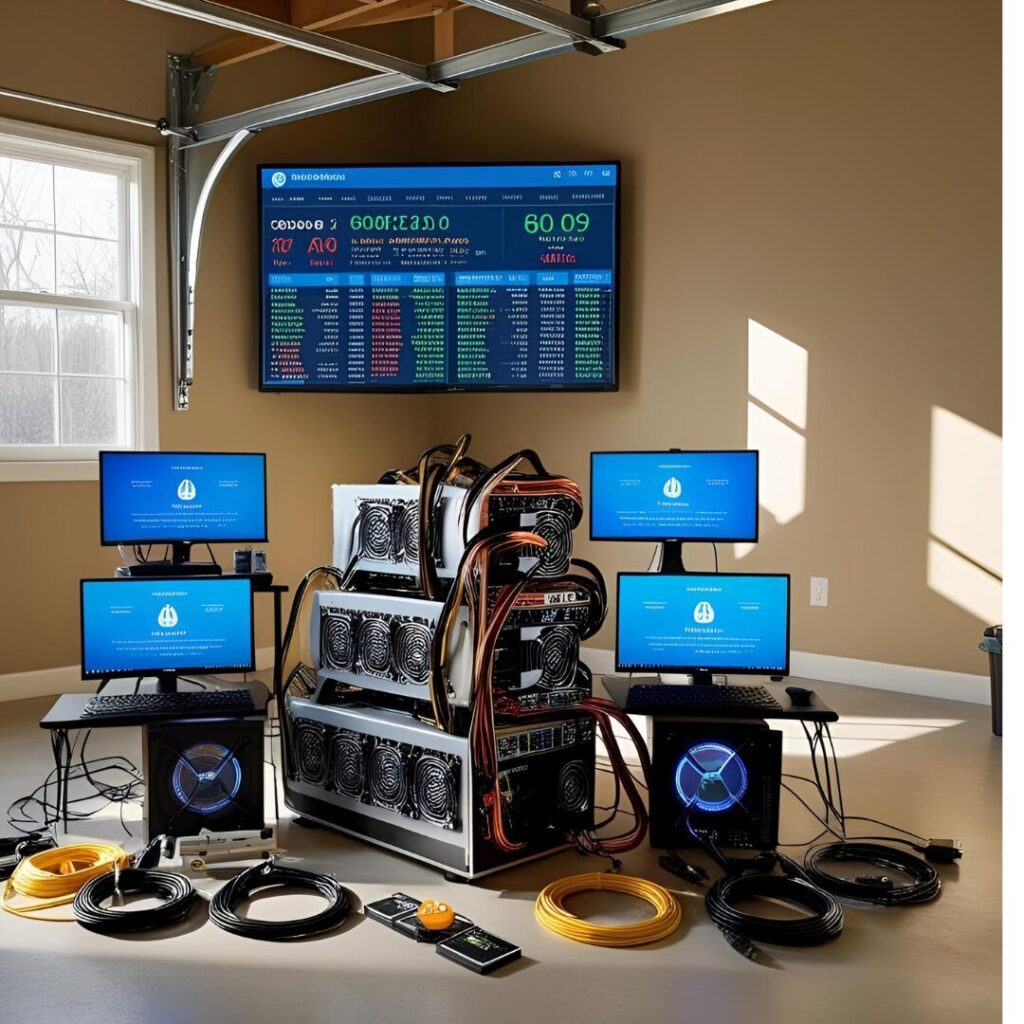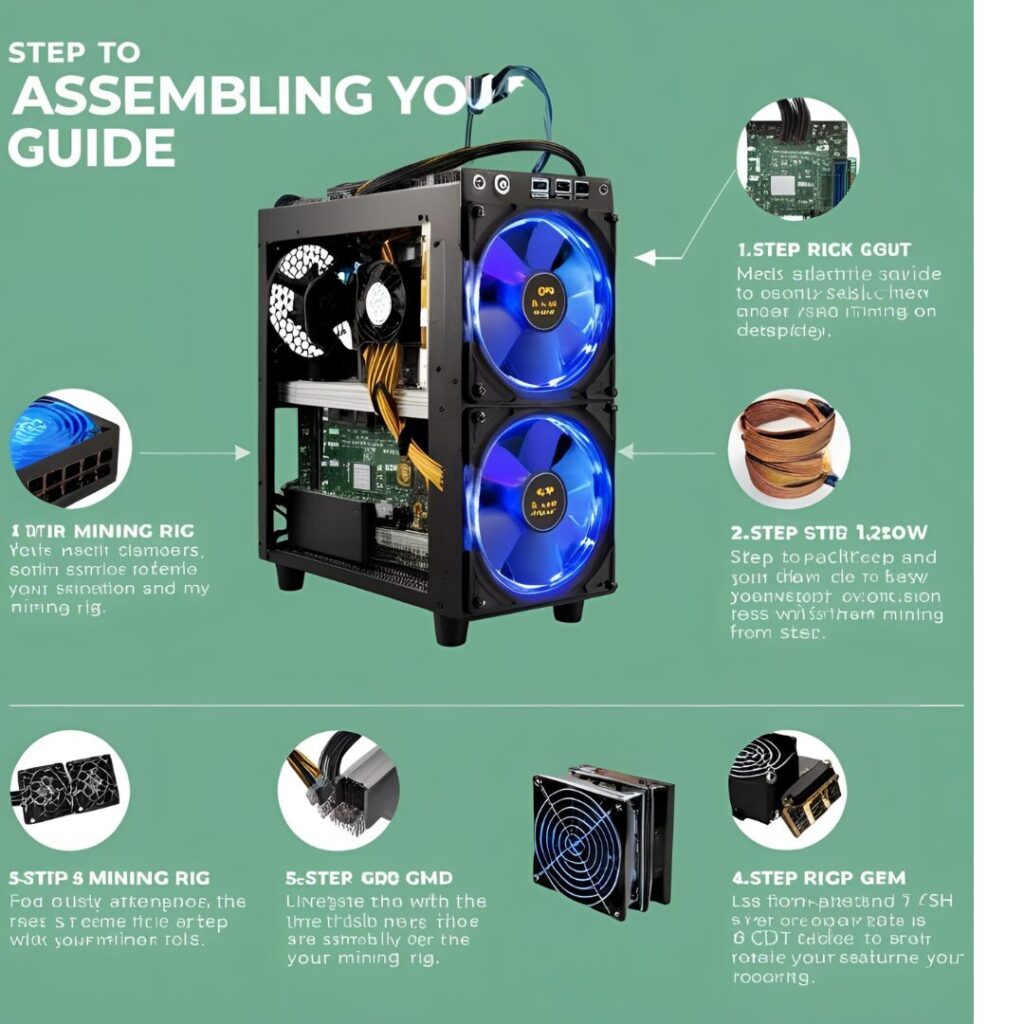Setting up crypto mining rig at home requires careful planning and execution. First, individuals must understand the essential components and their roles in the mining process. Choosing the right location is fundamental for efficiency and performance. Additionally, proper assembly and configuration of both hardware and software are necessary to maximize output. As the process unfolds, considerations like power consumption and cooling solutions become essential. Each step plays a critical role in the overall success of the mining operation.
Key Takeaways
- Choose a suitable location with good ventilation and away from living spaces to minimize noise and heat buildup.
- Assemble essential components like GPU, PSU, motherboard, cooling solutions, RAM, and storage to create a robust mining rig.
- Install a compatible operating system and mining software, and set up a digital wallet for secure cryptocurrency storage.
- Monitor performance metrics, including temperature and hash rate, using tools like MSI Afterburner to ensure optimal operation.
- Join mining communities online for support, tips, and to stay updated on industry trends and best practices.
Understanding Cryptocurrency Mining and Its Importance
Cryptocurrency mining plays a pivotal role in the functioning of decentralized blockchain networks. It involves validating transactions and adding them to the blockchain, ensuring security and integrity within the network. Miners utilize powerful computing hardware to solve complex mathematical problems, thereby competing to validate blocks and earn rewards in the form of cryptocurrency. This process not only secures the network but also facilitates the issuance of new coins, contributing to the overall supply and demand dynamics. As a result, mining fosters community engagement and decentralization, allowing individuals to participate in the ecosystem. Understanding cryptocurrency mining is essential for anyone looking to set up a mining rig at home, as it provides insight into the significance of their contributions to the blockchain landscape.
Essential Components of crypto Mining Rig
In the process of learning how to set up a mining rig at home, understanding the essential components is vital for ideal performance. This includes identifying the appropriate hardware requirements, such as graphics cards, power supplies, and motherboards, as well as the necessary software setup to manage the mining operations effectively. Each component plays a significant role in ensuring the efficiency and profitability of the mining rig.

Hardware Requirements
A successful mining rig requires several essential components to operate efficiently and yield ideal results. The cornerstone of any rig is the GPU, which handles the complex calculations necessary for mining. A robust power supply unit (PSU) guarantees stable energy delivery, while a compatible motherboard supports multiple GPU installations. Adequate cooling solutions, including fans or liquid cooling systems, prevent overheating during intensive operations. Additionally, sufficient RAM and storage space, often utilizing SSDs for faster data access, contribute to overall performance. Finally, a reliable casing houses these components, guaranteeing durability and optimal airflow. Understanding these hardware requirements is vital for anyone looking to learn how to set up a mining rig at home, fostering a sense of community among enthusiasts.
Software Setup Guide
Setting up the appropriate software is as important as selecting the right hardware for a crypto mining rig. The first step involves choosing an operating system; many miners prefer Linux due to its stability and efficiency, while others opt for Windows for its user-friendly interface. Next, install mining software compatible with the chosen cryptocurrency, such as CGMiner or PhoenixMiner, which provide advanced features for optimization. Additionally, a wallet must be set up to store earned coins securely. Miners should also consider joining a mining pool to enhance profitability through combined resources. Finally, configure the settings to optimize hardware performance, ensuring efficient energy consumption and maximum hashing power. Proper software setup is essential for achieving success in mining operations.
Choosing the Right Location for Your Mining Rig
Selecting an appropriate location for a crypto mining rig is critical for peak performance and efficiency. Key considerations include adequate space for the rig’s layout, sufficient power supply to handle energy demands, and effective ventilation to prevent overheating. Each of these factors plays a significant role in ensuring the mining rig operates safely and effectively in a home environment.

Space Requirements and Layout
Choosing the right location for a crypto mining rig is essential for enhancing performance and ensuring long-term sustainability. Space requirements should prioritize adequate ventilation, as mining rigs generate significant heat. A dedicated, well-ventilated area can prevent overheating and maintain peak operating conditions. The layout should also accommodate multiple rigs if expansion is anticipated, allowing for efficient airflow and easy access for maintenance. Additionally, consider proximity to a stable internet connection to minimize latency issues. Noise levels from the fans may also be a factor, so selecting a location away from living spaces is advisable. Ultimately, a thoughtful arrangement enhances the mining rig’s efficiency and contributes to a successful home mining operation, fostering a sense of community among enthusiasts.
Power Supply Considerations
Power supply considerations play a critical role in the efficient operation of a crypto mining rig at home. Selecting an appropriate location for the mining rig is essential, as it directly impacts power supply management. The rig should be positioned near an electrical outlet that can handle the required wattage without overloading circuits. Users must evaluate the power supply unit (PSU) rating, ensuring it meets the total wattage demands of the GPUs and other components. Additionally, utilizing a dedicated circuit can prevent interruptions during operation. It is crucial to minimize the length of power cables to reduce voltage drop and maintain stability. Ensuring a reliable and robust power supply setup fosters a sense of belonging within the mining community, where shared knowledge enhances overall success.
Ventilation and Cooling Needs
Effective ventilation and cooling are essential components in the operation of a home mining rig. High-performance mining rigs generate significant heat, necessitating a well-ventilated location to prevent overheating and maintain peak performance. Ideally, the mining rig should be placed in a room with ample airflow, such as a basement or garage, away from direct sunlight. Utilizing fans and exhaust systems can enhance air circulation, while thermal paste on GPU and CPU components can improve heat dissipation. Additionally, monitoring temperatures with software tools guarantees that hardware operates within safe limits. By prioritizing ventilation and cooling, miners create a stable environment that not only protects their investment but also fosters a sense of community among fellow enthusiasts committed to efficient mining practices.
Step-by-Step Guide to Assembling Your Mining Rig
Assembling a crypto mining rig at home requires careful attention to detail and a systematic approach to guarantee peak performance. Start by securing a sturdy frame to support all components. Next, install the power supply, confirming it meets the wattage requirements of the GPUs. Attach the motherboard to the frame, followed by the CPU and RAM. Connect the GPUs, using risers for ideal spacing and airflow. Each GPU should be connected to the power supply for adequate energy distribution. Verify all cables are organized to prevent tangling and overheating. Finally, check all connections before powering on the rig. This meticulous assembly process is essential for creating a reliable mining rig that can efficiently handle computational demands.

Configuring Software for Optimal Mining Performance
Configuring the software for ideal crypto mining performance is a critical step in the process of setting up a mining rig at home. First, users must select a suitable mining software compatible with their chosen cryptocurrency and hardware. Popular options include CGMiner, BFGMiner, and EasyMiner. After installation, users should configure the software settings, such as adjusting the intensity and thread concurrency to maximize hash rates without causing instability. It is also vital to connect to a mining pool for increased efficiency, providing stability in earnings. Regularly monitoring performance metrics and adjusting parameters as needed will help achieve peak results. Finally, keeping software updated guarantees access to the latest features and improvements, enhancing the overall mining experience.
Power Consumption and Cooling Solutions
Power consumption and cooling solutions are vital considerations when setting up a crypto mining rig at home. The mining process requires significant electrical power, which can lead to high energy bills. Efficient power supply units (PSUs) should be selected, ideally with an 80 PLUS certification to guarantee energy efficiency. Additionally, it is important to calculate the total wattage required by all components to avoid overloading circuits. Effective cooling is equally important; high-performance GPUs generate substantial heat. Implementing adequate ventilation, using fans, or even liquid cooling systems can enhance performance and extend hardware lifespan. Properly managing both power consumption and cooling solutions guarantees not only the efficiency of the mining rig but also the safety and sustainability of the home environment.
Monitoring and Maintaining Your Mining Rig at Home
Monitoring a mining rig at home is essential for ensuring ideal performance and longevity of the hardware. Regular assessments of temperature, hash rate, and power consumption are critical for maintaining efficiency. Specialized software, such as MSI Afterburner or CGMiner, can provide real-time metrics, alerting users to any anomalies. Users should also routinely check for dust accumulation, as this can lead to overheating. Scheduled maintenance, including reapplying thermal paste and ensuring proper airflow, is crucial. Additionally, joining online communities can offer support and shared experiences, fostering a sense of belonging among miners. By effectively monitoring and maintaining the rig, individuals can optimize their operations, ultimately enhancing their mining success while building connections within the mining community.
Frequently Asked Questions
What Is the Initial Cost of Setting up a Mining Rig?
The initial cost of setting up a mining rig typically ranges from $1,000 to $3,000, depending on hardware choices, including graphics cards, power supplies, and motherboards, alongside potential additional expenses for cooling and housing the rig.
Can I Mine Multiple Cryptocurrencies With One Rig?
Yes, one crypto mining rig can mine multiple cryptocurrencies, provided it supports different algorithms. However, efficient performance depends on the rig’s hardware capabilities and software configurations, necessitating careful management of resources for ideal results.
How Long Does It Take to Break Even on My Investment?
The time required to break even on a mining investment varies considerably, often ranging from several months to over a year, depending on factors like initial costs, electricity rates, and cryptocurrency market volatility.
Is Mining at Home Legal in My Area?
Determining the legality of mining at home requires researching local regulations, as laws vary considerably by jurisdiction. Individuals should consult their local government or legal resources to guarantee compliance with zoning and electrical codes.
What Are the Tax Implications of Cryptocurrency Mining?
The tax implications of cryptocurrency mining vary greatly by jurisdiction. Income generated from mining is often taxable, requiring miners to report earnings, while expenses related to equipment and electricity may be deductible under certain conditions.
Conclusion
Ultimately, successfully setting up a mining rig at home requires careful consideration of various components, location, and software configuration. By ensuring proper ventilation, selecting high-performance hardware, and implementing effective cooling solutions, miners can optimize their rig’s performance. Regular monitoring and maintenance are essential to sustain efficiency and prolong the longevity of the setup. By following this guide, individuals can effectively engage in cryptocurrency mining and potentially enhance their profitability in this dynamic field.

